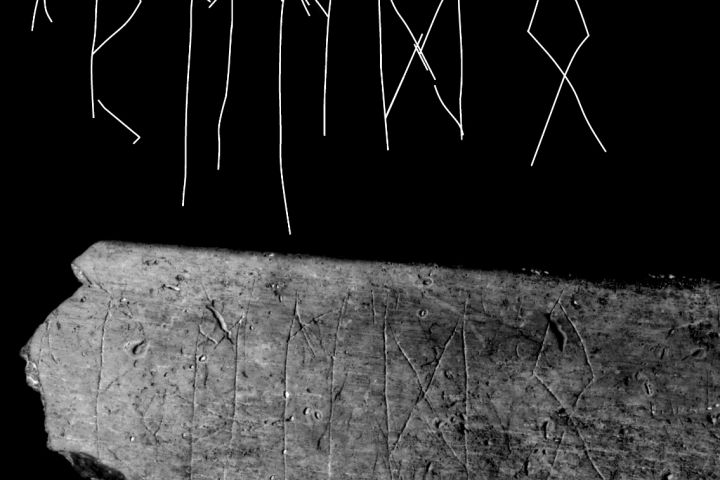
Runes as the oldest inscription among Slavs
Learning from a Scientific Paper, March 2021, Runes from Lány (Czech Republic) - The oldest inscription among Slavs. An Ancient Debate #archeology #Slavic Since the 19th century, Slavonic scholars had theorized that Slavs had achieved literacy pre-Christ Art, Education, Symbols and Signs, SpiritualityRunes as the oldest inscription among Slavs
Neolithic European wisdom, symbols and divine learning from a Scientific Paper, March 2021, Runes from Lány (Czech Republic) - The oldest inscription among Slavs
An Ancient Debate #Archeology #Slavic #History. Since the 19th century, Slavonic scholars had theorized that Slavs had achieved literacy pre-Christ.
Symbols and Signs Research by Nataša Pantović
Like many extraordinary discoveries, it happened by accident, just recently, and it sparked a number of years of careful scientific research.
A Czech archaeologist, Alena Slamova, was routinely cleaning the excavations from a dig when her sharp eye noticed unusual scratching on the surface of one fragment. So she has decided to examine it further with her colleagues, not dispose of it.
"Our find is the first one after nearly 200 years of discussions to suggest that it is possible that the [early Slavs] had some script," says Jiri Machacek, head of the Department of Archaeology in Brno, the co-author of the report.

The rune bone was found near the town of Breclav in what is now the Czech Republic
Alena Slamova and Jiri Machacek with the fragment of cow rib that could change a lot of what we know about the early Slavs
Runes are an alphabetic script, called fuþark, used among Germanic tribes
What scientists are after are abecedaries (passed through Europe as a script). Longer time period, more difficult the find. I.e. many inscriptions exist in younger fuþark, and there are only about 430 in older fuþark, used until 700 AC, of which only 17 contain complete, or incomplete abecedaries. Less than 100 span from 300 AC to 700 AC creating what is known as the South-Germanic corpus.
A researcher can easily imagine that the most scripts found would belong to our wealthy and influential men's graves (in Balkan read: Germanic or Ottoman or Byzantine).
During the last 2,000 years, the only women buried were Queens or Saints, surely not slaves. In Balkans, since Slavs were slaves, changing the names to reflect the power-God-Goddess structure (for example Dio-nisus. or Herodotus, or St Whoever Christian Name) was common.
What has survived came from the scripts found on metal objects in 600 AC graves containing personal names. It is a typical example of an Early Slavic settlement of the 6-700 AC. The same ones you find following the river Danube. The above mentioned rib bone fragment, originates from Břeclav Lány in South Moravia, Czechia.
Codex Runicus, 1300 AC containing one of the oldest and best preserved texts of the Scanian law (Skånske lov), written entirely in runes.
“This important find renders six of the last eight runes of the older fuþark, making it the first find containing the final part of the older fuþark in South-Germanic inscriptions, and the only one found in a non-Germanic context.”
The first written reports about Slavs, referred to Slavs as Sclavini, and their attacks on the Byzantine & later Ottoman Empire during the 600 AC – 1,500 AC. Early written mentions of Slavs include Sclauos in the 777AC, 805 AC, 822 AC, 855AC, etc.
This rune-inscribed fragment of a bone could be the first archaeological evidence for a direct contact between Germanic and Early Slavic tribes in Europe from the late 600 BC found in any Slavic settlement said the groundbreaking report.
As often happens with important archaeological discoveries, the Lany bone may shed light on old historical mysteries but also raises new questions that could open up enticing avenues of research.
One interesting puzzle facing scholars is to figure out why a Germanic script ended up being used in a Slavic setting. There is a possibility that it was written by Slavs who learned it from a Germanic tribe, or the Germanic people have learned it from the Slavs.
It is a tantalizing question that might not be solved for unfortunately, the Lany bone is the only physical evidence to date of writing among early Slavs.
"Nobody was interested in looking for inscriptions on these bones because we had no idea that something like this could be here,” says Machacek. "So perhaps now that we have this first find, we and other archaeologist colleagues will attempt to look for more… There are thousands of animal bones, and this writing could also be on some of these."
The deeply engraved runic inscriptions are no doubt authentic, they have been confirmed using optical & electron microscopy.
Yet, the conventional scientist, Robert Nedoma, an expert in comparative literature at the University of Vienna, has categorically identified it as “Elder Futhark”, the oldest known form of runic lettering used by Germanic speaking inhabitants of Central Europe.
This “categorical identification” cannot come from a Slavic Phd holder from a Balkan country because our cultural upbringing of Slaves to Germanic or Ottoman powers, during the past 2,000 years, has given us, Slavs, only a very strong “doubt as the scientific principal”.
I often wonder does this “scientific certainty” ignite this age-long nationalism.
This ancient system consisted of 24 letters.
The Serbian Vinča’s (A Danube settlement spanning 6,000 years in Neolithic Europe’s Serbia) sculptures, artifacts have used symbols for religious purposes, and these were always placed in a particular manner around the head of the sculpture.
The Egyptian script had used symbols for magical purposes.
Slavs with their maternal culture mainly used cremation graves, a few burned bones and pots. The inscription would have been on wood and burnt. Machacek suggests that the discovery of the Lany bone could eventually resonate far beyond the halls of academia.
"This period at the very beginning of the Middle Ages is a very important era," he says. "It is the period of the establishment of these nations and states in Europe that exist until now. They are our roots, and therefore, it is a very sensitive period."
"This mystery of runes was really abused in the late history, in Germany by Nazis and so on," he says. "It is a very sad history, but now we can perhaps show that this script and these runes could have been more common among various groups and various nations. And they are perhaps not only connected with Germanic mythology and Germanic history but could be part of the common heritage of Central European people generally."
Machacek says his team has received funds from the Czech Science Foundation (GACR) to continue excavating at Lany."
Runes from Lány (Czech Republic) - The oldest inscription among Slavs
According to some anthropologists, there is no evidence for a mass migration of Slavs through Europe. According to many linguists, by 1,000 AC, Slavic speakers were all around Europe, switching languages from Greek or German or Roman to Slavic.
“At the continental scale, modern Slavic speakers were found to share more haplotypes among each other than with other Europeans. This was initially also interpreted as evidence for a demic expansion (Hellenthal et al., 2014; Ralph and Coop, 2013), but might be equally consistent with low population size (Al-Asadi et al., 2019; Ringbauer et al., 2017).”
Journal of Archaeological Science, Volume 127, March 2021, Runes from Lány (Czech Republic) - The oldest inscription among Slavs. A new standard for multidisciplinary analysis of runic bones.
“In the central Danube region, for instance, Germanic, Avar and Slavic settlement followed each other very closely in time... As defined by M. Parczewski (2004) based on finds from Ukraine and Poland, typical Early Slavic settlements
i) are located on the edge of a river valleys,
ii) allowed for a self-sufficient lifestyle, and
iii) consisted of small sunken-floor huts with a stone or clay oven and built on a square plan.
iv) cremation was the predominant funeral rite, and
v) no well-developed handicrafts other than rudimentary iron works and handmade undecorated pottery of the Prague type existed.”
This raises the intriguing question as to why no other samples of early Slavic writing have been found.
Gaia has unfortunately passed through a destruction of gigantic proportions, the 1st and 2nd World War, shaking the Europe’s, Balkan’s or Polish Lands where this particular ancient Slavic ruin had been discovered. Now, imagine this, how much we must honor our young or old archeology graduates, working in the field, researchers who fully comprehend how meticulously rare markings of any sorts are. Within the same scenario, the same meticulous graduates, digging, researching said -
"It was absolutely surprising for us," says Jiri Machacek, head of the Department of Archaeology in Brno, the co-author of the report.
According to Machacek, the fragment of cow rib, the engravings his student found turned out to be runic lettering, something that could change a lot of what we know about the early Slavs and their settlement. This amazing archeological artifact was excavated in an early Slavic settlement, so this invention might, in our near future, change some important scientific assumptions. Alena’s discovery has reignited archeological, linguistic and historical controversies and shed new light on Slavic European past.
An inscription using cipher runes, the Elder Futhark, and the Younger Futhark, on the 9th-century Rök runestone in Sweden
An Ancient Debate
It had long been believed that the Orthodox Serbian (Macedonian) Christian missionaries Cyril and Methodius have introduced a writing system, now called Cyrillic, now used only in Greece, Serbia, Macedonia, and Russia during the 900 AC. Slavs that have been converted to Roman Catholic fate and Islam have started using Glagolitic script instead. But this date is some 300 years after the inscription on the Lany bone, which has been dated using genetic and radiocarbon methods to around 600 AC.
The idea that Slavs had learned writing earlier has long been a matter of debate.
As far back as the 19th century, Slavonic scholars had explored the idea that Slavs had already achieved literacy in the pre-Christian era.
One of the main cornerstones of the argument is a text from 900 AC by a Slavic Bulgarian scholar/monk named Chernorizets Hrabar. Hrabar in Serbian literally means “Courageous” for he indeed needed courage to portray this line of thought.
He made reference to a system of writing using "strokes and incisions" adopted by the early Slavs.
However, there is a twist to this interesting scientific tale.
How an “alien alphabet” in 600 AC came to be adopted (used by Priests or Kings for only kings or priests had any form of education) by these early Slavs if the so-called "great migration" of Slavic peoples had just happened.
The runic script has historically only been associated with Germanic tribes.
"The Slavicization of Europe is really a little bit of a mystery," says Machacek. "And the theory that it involved the migration of masses of people is not so easy to scientifically demonstrate…. Our discovery should be a small part of this discussion."







Runes as the oldest inscription among Slavs No comments on Runes as the oldest inscription among Slavs: